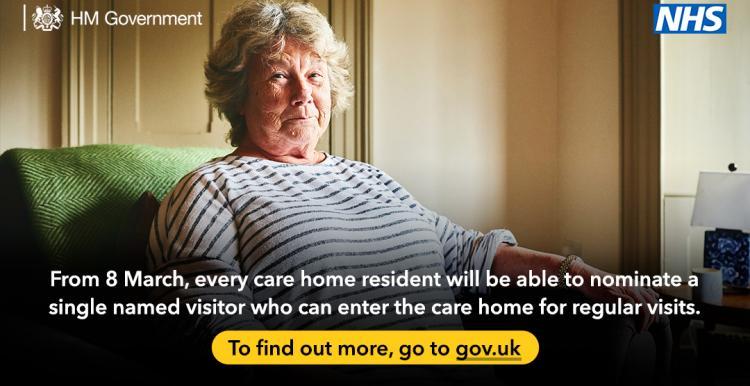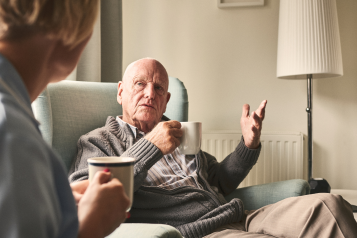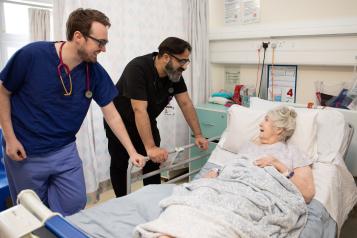What you need to know when visiting a care home (new guidance for COVID-19)

This guidance applies from 8 March 2021 and replaces previous guidance on care home visiting. It applies to care homes for working-age and older adults.
The arrival of COVID-19 has meant that many restrictions have been placed on care homes to prevent the spread of infection and ensure the health and safety of both care workers and its residents.
Directors of public health (DPHs) and care providers should follow this guidance to ensure policies for visiting arrangements and decisions are based on a dynamic risk assessment and minimise risk wherever possible.
This guidance has been taken from gov.uk.
New Guidance from 12 April 2021
From Monday 12 April, residential care providers can arrange for visits to residents from two named visitors and a single essential caregiver. Visitors who are parents will also be able to visit with babies and very young children, who will not count as one of the visitors.
Government guidance setting out these arrangements replaces previous guidance which allowed single named visitors.
The arrival of COVID-19 has meant that many restrictions have been placed on care homes to prevent the spread of infection and ensure the health and safety of both care workers and its residents.
Directors of public health (DPHs) and care providers should follow this guidance to ensure policies for visiting arrangements and decisions are based on a dynamic risk assessment and minimise risk wherever possible.
This guidance has been taken from gov.uk.
When will I be able to visit a care home?
As of Monday 8 March, every care home resident will be able to nominate a single named visitor who will be able to enter the care home for regular visits.
To support the news, the government is set out guidance to ensure safety when visiting;
- Nominated visitors should be tested using rapid lateral flow tests before every visit.
- Additionally, they must wear appropriate personal protective equipment (PPE) and follow all other infection control measures (which the care home will guide them on) during visits.
- Physical contact must be kept to a minimum. Visitors and residents may wish to hold hands but should bear in mind that any contact increases the risk of transmission.
- There should not be close physical contact such as hugging.
Can we nominate more than one visitor?
At present, only one person can be nominated as a regular visitor. it is hoped that if the data shows it is safe this can be increased to two visitors as of 12 April 2021, but no earlier. More detail can be found on the Government Roadmap
Note - Care homes can continue to offer visits to other friends or family members with arrangements such as outdoor visiting, substantial screens, visiting pods, or behind windows.
Go to full guidance
For the most up to date guidance, including information of what should be included in your care home’s visiting policy, visit the Gov.uk website.
See also the guidance for supported living settings.
Will the guidance change depending on which COVID-19 alert level I'm in?
The government will look carefully at the effectiveness of the vaccine for people living in care homes (and for the clinically extremely vulnerable generally), as well as levels of infection in the local community, especially of any new variants.
How do I find out the visiting policy of a care home?
Advice for residents and families should be set out in the visiting policy of the care home and shared with you. This advice should cover issues such as:
- visitors should be given support on how to prepare for a visit and given tips on how to communicate if face coverings are required, for example:
- speaking loudly and clearly
- keeping eye contact
- not wearing hats or anything else that might conceal their face further
- wearing clothing or their hair in a way that a resident would more likely recognise
- provide reassurance to visitors, including that some people with dementia might struggle at first to remember or recognise them. Care home staff should try and prepare the resident for a visit, perhaps by looking at photographs of the person who is due to visit and talking to them about their relationship
The frequency of visits is likely to be limited and/or controlled and is down to the specific circumstances of the care home and those living and working within it.
It is recommended that the home has the arrangement to enable booking/appointments for visitors. If the home has previously operated an ‘open door’ visiting policy, then you should be informed of the change of arrangements and why this is necessary.
Can I arrange a visit for my loved one outside the care home setting?
Guidance for visits out of a care home, for example to a family home, is in development and will be provided shortly.
Do I need to take a test to be able to visit my relative?
Yes, however, if you are displaying any symptoms of coronavirus you should not visit the care home, self-isolate, and order a test immediately.
You may be asked screening questions upon arrival. These include:
- Have you been feeling unwell recently?
- Have you had recent onset of a new continuous cough?
- Do you have a high temperature? A care home may consider providing a temperature check for all visitors to provide confidence to visitors and to staff.
- Have you noticed a loss of, or change in, normal sense of taste or smell?
- Have you had recent contact (in the last 14 days) with anyone with COVID-19 symptoms or someone with confirmed COVID-19 – if yes, should you be self-isolating as a family member or as a contact advised to do so by NHS Test and Trace?
How do I travel to the care home?
It is encouraged that you walk to the home or use your own transport where possible.
It might be that some assistance is required to enable visitors who are especially vulnerable to get to the care home. Care homes may consider giving visitors telephone numbers or website information of organisations which can offer advice on safe travel arrangements if required.
What is likely to change when I visit my loved one?
You can expect to see a number of changes but remember they are to keep you and your loved ones safe. These include:
- Care workers will use Personal Protective Equipment (PPE) in line with guidance from Public Health England and you are will be asked to wear a mask and/or visor when you are in the building. If you are making close personal contact with a resident you may need to wear PPE which goes beyond a face covering.
- Care homes with an ‘open door’ policy may have to work towards a more regimented booking system. Ad hoc visits are not advised.
- Care homes should support NHS Test and Trace by keeping a temporary record (including address and phone number) of current and previous residents, staff and visitors, as well as keeping track of visitor numbers and staff.
- Visitors should have no contact with other residents and minimal contact with care home staff (less than 15 minutes / 2 metres). Where needed, conversations with staff can be arranged over the phone following an in-person visit
What happens if I can’t see my family or friend in the care home?
If there is a restriction to visitors in place, alternative ways of communicating between residents and their families and friends should be discussed and offered. The care home should also provide regular updates to residents’ loved ones on their mental and physical health, how they are coping and identify any additional ways they might be better supported, including any cultural or religious needs.
Visits to a COVID-19 positive resident should only be made in essential circumstances (for example, end of life).
What happens if there is an outbreak at the care home?
If there is a declared outbreak in a care home then the visiting guidance will need to be restricted for a period of time until the care home has been assessed to be in recovery. You should be informed of this.
Get in touch
Do you want to talk to someone about what these changes mean for care homes near you?


